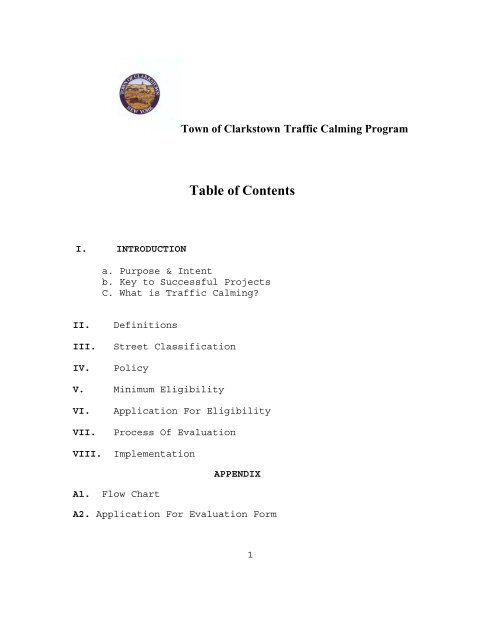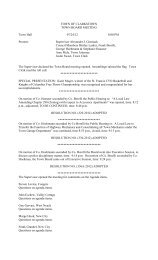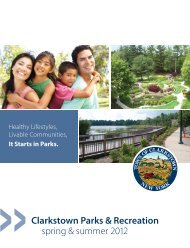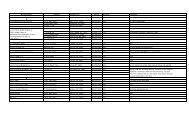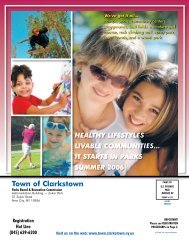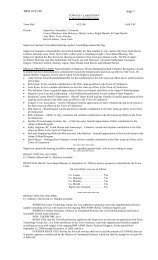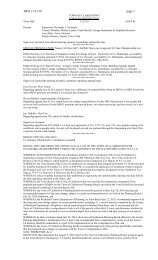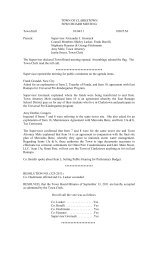Traffic Calming Program Application - Town of Clarkstown
Traffic Calming Program Application - Town of Clarkstown
Traffic Calming Program Application - Town of Clarkstown
Create successful ePaper yourself
Turn your PDF publications into a flip-book with our unique Google optimized e-Paper software.
<strong>Town</strong> <strong>of</strong> <strong>Clarkstown</strong> <strong>Traffic</strong> <strong>Calming</strong> <strong>Program</strong><br />
Table <strong>of</strong> Contents<br />
I. INTRODUCTION<br />
a. Purpose & Intent<br />
b. Key to Successful Projects<br />
C. What is <strong>Traffic</strong> <strong>Calming</strong>?<br />
II.<br />
III.<br />
IV.<br />
Definitions<br />
Street Classification<br />
Policy<br />
V. Minimum Eligibility<br />
VI.<br />
VII.<br />
<strong>Application</strong> For Eligibility<br />
Process Of Evaluation<br />
VIII. Implementation<br />
APPENDIX<br />
A1. Flow Chart<br />
A2. <strong>Application</strong> For Evaluation Form<br />
1
I. INTRODUCTION<br />
A. Purpose & Intent<br />
The <strong>Town</strong> Board <strong>of</strong> the <strong>Town</strong> <strong>of</strong> <strong>Clarkstown</strong> recognizes that<br />
neighborhoods within the <strong>Town</strong> are experiencing excessive<br />
traffic, speeding and, in some areas, a high rate <strong>of</strong><br />
accidents. This <strong>Traffic</strong> <strong>Calming</strong> <strong>Program</strong> has been developed<br />
to provide a safer environment for pedestrians, bicyclists<br />
and motorists throughout the <strong>Town</strong>. Through the development<br />
<strong>of</strong> guidelines, criteria and procedures for evaluating and<br />
implementing various traffic calming measures, the <strong>Town</strong><br />
Board intends to employ new and creative mechanisms in an<br />
attempt to mitigate some <strong>of</strong> these prevailing issues and in<br />
so doing, improve the quality <strong>of</strong> life in <strong>Clarkstown</strong>.<br />
B. Key to Successful Projects:<br />
The key to any successful traffic calming program is<br />
choosing the appropriate measure(s) for a specific problem.<br />
Residents and/or neighborhoods must identify specific<br />
streets or intersections involved, direction <strong>of</strong> traffic,<br />
day(s) <strong>of</strong> the week, time(s) <strong>of</strong> day and other factors when<br />
the specific problems are evident. <strong>Town</strong> staff may need to<br />
conduct traffic counts and speed counts and accident<br />
studies to verify the extent <strong>of</strong> the problem. Since traffic<br />
calming measures can be expensive and create inconvenience,<br />
a wide base <strong>of</strong> neighborhood support is essential, as well<br />
as an understanding <strong>of</strong> the impact <strong>of</strong> the traffic calming<br />
measures on the surrounding areas.<br />
Neighborhood support, enforcement, education <strong>of</strong> motorists,<br />
bicyclists and pedestrians, appropriate engineering<br />
applications and economics typically determine the success<br />
<strong>of</strong> any traffic calming endeavor. A cooperative partnership<br />
between local residents and the <strong>Town</strong> is essential to the<br />
success <strong>of</strong> the project.<br />
2
Each traffic-calming project should include community<br />
awareness and education components, including:<br />
• Distribution <strong>of</strong> traffic safety brochures within<br />
the neighborhood. area schools, and businesses;<br />
• Presentations <strong>of</strong> various educational programs on<br />
child safety seats. Buckle-up NY (Seatbelt<br />
<strong>Program</strong>), pedestrian safety, bicycle safety,<br />
enforcement presentations (CPD), and safe driving<br />
tips;<br />
• Identification <strong>of</strong> a safe walking route to school<br />
if a school is in the impacted area;<br />
• Public service announcements to remind motorists<br />
<strong>of</strong> the consequences <strong>of</strong> speeding;<br />
• <strong>Traffic</strong> counts to determine actual speeds,<br />
traffic volumes and peak periods <strong>of</strong> each;<br />
• Speed Monitoring Awareness Radar Trailer (SMART)<br />
-a mobile trailer equipped with a radar gun and a<br />
speed limit sign to show motorists their speed in<br />
comparison with the posted speed limit;<br />
• Enforcement <strong>of</strong> speed limits.<br />
• Endorsement by the local enforcement agencies and<br />
emergency service providers.<br />
C. What is <strong>Traffic</strong> <strong>Calming</strong> ?<br />
<strong>Traffic</strong> calming is "the combination <strong>of</strong> mainly physical<br />
measures that reduce the negative effects <strong>of</strong> motor vehicle<br />
use, alter driver behavior and improve conditions for nonmotorized<br />
street users." [Institute <strong>of</strong> Transportation<br />
Engineers (ITE) in the publication<br />
<strong>Traffic</strong> <strong>Calming</strong>: State <strong>of</strong> the Practice].<br />
The <strong>Town</strong> <strong>of</strong> <strong>Clarkstown</strong> includes the following as key<br />
components <strong>of</strong> its traffic calming program:<br />
1.) Evaluation<br />
2.) Education<br />
3.) Enforcement<br />
4.) Visual Measures<br />
5.) Physical Measures<br />
6.) Assessment<br />
3
II. DEFINITIONS<br />
AADT -Average Annual Daily <strong>Traffic</strong><br />
CHD -<strong>Clarkstown</strong> Highway Department<br />
CPD -<strong>Clarkstown</strong> Police Department<br />
CNTCTF -<strong>Clarkstown</strong> Neighborhood <strong>Traffic</strong> <strong>Calming</strong> Task Force<br />
Cut-Through <strong>Traffic</strong> -Through traffic diverted from arterial<br />
and collector streets onto local residential streets to<br />
avoid congestion.<br />
Impacted Area -Vicinity in which a specific street and<br />
adjacent streets will be affected by the <strong>Traffic</strong> <strong>Calming</strong><br />
Measure<br />
Local Residential Streets -Intended to serve primarily as<br />
an access to abutting property.<br />
Neighborhood Notification Area -Affected area which<br />
identifies particular streets and households within a<br />
specified radius, necessary for the <strong>Town</strong> to notify.<br />
NYSDOT -New York State Department <strong>of</strong> Transportation<br />
NYSMUTCD -New York State Manual <strong>of</strong> Uniforrn <strong>Traffic</strong> Control<br />
Devices<br />
Road Work Permit -Written authorization from CHD to<br />
commence work within the <strong>Town</strong> Right <strong>of</strong> Way. Also referred<br />
to as an ‘Excavation Permit’ or ‘Road Opening Permit’ per<br />
Chapter 250 <strong>of</strong> the <strong>Town</strong> Code.<br />
T&TFSAB -<strong>Traffic</strong> & <strong>Traffic</strong> Fire Safety Advisory Board<br />
<strong>Town</strong> -<strong>Town</strong> <strong>of</strong> <strong>Clarkstown</strong><br />
<strong>Town</strong> Board -The <strong>Town</strong> Council <strong>of</strong> the <strong>Town</strong> <strong>of</strong> <strong>Clarkstown</strong><br />
4
<strong>Traffic</strong> <strong>Calming</strong> Measures -Methods used to reduce vehicular<br />
speed and volume and increase the sharing <strong>of</strong> streets by<br />
pedestrians and other users. Generally refers to physical<br />
measures and roadway design changes; education,<br />
enforcement and visual measures may be components.<br />
<strong>Traffic</strong> <strong>Calming</strong> Study -An appraisal <strong>of</strong> traffic conditions<br />
and the development <strong>of</strong> a plan for implementing one or more<br />
traffic calming devices.<br />
<strong>Traffic</strong> Count Study –A study using equipment to measure,<br />
collect and statistically analyze the speeds <strong>of</strong> vehicle,<br />
volumes computed to AADT.<br />
TTAC -<strong>Traffic</strong> Technical Advisory Committee. Comprised <strong>of</strong><br />
<strong>Town</strong> staff from CHD, CPD, other Departments and consultants<br />
as designated by the <strong>Town</strong> Board to act in an advisory,<br />
investigative and administrative capacity to the T&TFSAB<br />
and <strong>Town</strong> Board.<br />
III.<br />
STREET CLASSIFICATION<br />
A. Arterials – NYS Roads, Streets and Highways under the<br />
jurisdiction <strong>of</strong> the NYSDOT.<br />
B. Major Streets or Highways – County roads under the<br />
jurisdiction <strong>of</strong> the Rockland County Highway Department<br />
and <strong>Town</strong> Roads with a double yellow line.<br />
C. Commercial & Industrial Street – As defined in Chapter<br />
254 <strong>of</strong> the <strong>Town</strong> Code “Subdivision <strong>of</strong> Land”, these are<br />
in areas zoned for commerce or industry, may<br />
reasonably be expected to carry a substantial volume<br />
<strong>of</strong> commercial and industrial traffic and create a<br />
shorter route between their area and a major traffic<br />
artery. These also may be on or close to the dividing<br />
line between residential and commercial areas.<br />
D. Local Residential Streets – These streets serve<br />
primarily as an access to abutting properties and are<br />
classified as:<br />
5
1.Suburban type streets: These serve<br />
subdivisions with lots under one acre in<br />
size, are not reasonably expected to become<br />
a through, commercial or industrial street,<br />
and may be a dead-end, loop or other minor<br />
street as distinguished from a principal<br />
collector road.<br />
2. Rural-type streets: These serve<br />
subdivisions with lots <strong>of</strong> a minimum <strong>of</strong> one<br />
acre in size where further downzoning is not<br />
anticipated and cannot be reasonably<br />
expected to become an extension or<br />
continuation <strong>of</strong> A., B., or C. above. If such<br />
extention or continuation occurs, the street<br />
will take on the classification the<br />
continued street. These streets do not or<br />
cannot reasonably be expected to carry a<br />
substantial volume <strong>of</strong> traffic.<br />
IV.<br />
POLICY<br />
1. All streets under municipal jurisdiction shall be<br />
eligible for the following traffic calming measures;<br />
Education, Enforcement and Visual Measures.<br />
2. Streets will generally be considered for physical<br />
traffic calming measures only after education,<br />
targeted enforcement and visual measures have been<br />
applied and their effects assessed.<br />
3. <strong>Traffic</strong> calming measures are not eligible if they<br />
compromise roadway safety (e.g limited sight distance<br />
or severe grades) or are deemed ineligible based on<br />
other engineering analysis or judgment.<br />
4. The T&TFSAB and TTAC shall recommend traffic calming<br />
measures based on criteria outlined in Section V.<br />
5. The T&TFSAB and the TTAC will submit their<br />
recommendations to the <strong>Town</strong> Board for their review and<br />
action.<br />
6. Periodically the T&TFSAB and the TTAC will review these<br />
criteria to determine whether they are appropriate for<br />
current conditions.<br />
6
V. MINIMUM ELIGIBILITY<br />
A. BACKGROUND<br />
The eligibility criteria are designed to ensure that<br />
traffic calming measures are implemented in appropriate<br />
areas. The <strong>Town</strong> <strong>of</strong> <strong>Clarkstown</strong> has patterned its program<br />
after successful programs in other cities and states<br />
particularly Minneapolis, MN, South Carolina DOT, Concord,<br />
CA, Rye, NY, Anchorage, AK, Delaware, Washington, DC and<br />
the <strong>Town</strong> <strong>of</strong> Orangetown, NY.<br />
These programs base <strong>Traffic</strong> <strong>Calming</strong> eligibility on speed,<br />
volume, characteristics <strong>of</strong> the area, grades, sight<br />
distance, and neighborhood acceptance.<br />
B. ELIGIBILITY CRITERIA FOR PHYSICAL TRAFFIC CALMING<br />
MEASURES:<br />
1. For Local Residential Rural-Type Streets<br />
a. A minimum <strong>of</strong> 500 vehicles per day<br />
b. 85th percentile speed exceeding the speed limit by 7<br />
mph<br />
c. Minimum segment length <strong>of</strong> 600 feet<br />
2. For Local Residential Suburban-Type Street<br />
a. A minimum <strong>of</strong> 1,500 vehicles per day<br />
b. 85th percentile speed exceeding the speed limit by 9<br />
mph<br />
c. Minimum segment length <strong>of</strong> 600 feet<br />
7
C. Physical <strong>Traffic</strong> <strong>Calming</strong> Measures on a Local<br />
Residential Rural–Type Street and Local Residential<br />
Suburban-Type Street are subject to the following existing<br />
conditions:<br />
1. Curbs and gutters 7.Residences fronting on street<br />
2. Grade 8. On-street parking<br />
3. Curvature <strong>of</strong> street 9. Sight distances<br />
4. School bus route/<br />
transit routes<br />
10. Safety considerations<br />
5. Adjacent arterials 11. Drainage<br />
6. Previous traffic<br />
engineering<br />
D. The Minimum Distance from Proposed Physical <strong>Traffic</strong><br />
<strong>Calming</strong> Measure To:<br />
a) Signals -Intersection 300 ft.<br />
b) Stop Signs 150 ft.<br />
c) Other Speed Control Measure 135 ft.<br />
d) Intersections 100 ft.<br />
e) Driveways/Alleys 20 ft.<br />
f) Curves Hills affecting sight<br />
lines<br />
200 ft.<br />
g) Mid-block Crosswalks 100 ft.-unless raised<br />
h) Railroad Crossing 200 ft.<br />
E. STREETS INELIGIBLE FOR PHYSICAL TRAFFIC CALMING<br />
MEASURES ARE:<br />
1. State or County Highways or a <strong>Town</strong> Road with a double<br />
yellow line;<br />
2. Streets classified other than local rural or local<br />
suburban residential, including arterial streets or<br />
highways;<br />
3. Streets used as a routine emergency service route or a<br />
major- public service route;<br />
8
4. Streets scheduled for resurfacing or reconstruction<br />
within the next two budget years. If all other criteria are<br />
met, traffic calming measures shall be installed during<br />
construction or resurfacing if possible;<br />
5. Streets with grades, curvatures, or other physical<br />
conditions that make the application <strong>of</strong> Physical <strong>Traffic</strong><br />
<strong>Calming</strong> Measures unsafe.<br />
VI.<br />
APPLICATION FOR ELIGIBILITY<br />
Residents and/or neighborhood associations wishing to have<br />
traffic calming measures considered for a specific street<br />
must submit a written application for evaluation, as<br />
prescribed in the form in the appendix, to the T&TFSAB. The<br />
request must be endorsed by a minimum <strong>of</strong> ten households or<br />
25% <strong>of</strong> the households on a specific street.<br />
The T&TFSAB will request that the TTAC gather the necessary<br />
information to determine project eligibility. Its results<br />
will be submitted to the T&TFSAB and the <strong>Town</strong> Board.<br />
The TTAC will develop the following data to determine<br />
whether the specific street is eligible for traffic calming<br />
measures, taking into consideration the impact on the<br />
surrounding area:<br />
Streets Affected (Neighborhood Notification Area);<br />
Description <strong>of</strong> impacted areas, with map. (The impacted area<br />
is generally a neighborhood area as defined by the TTAC in<br />
cooperation with the T&TFSAB);<br />
Description <strong>of</strong> petition area, with map. (The petition area<br />
is the area bounded by the surrounding collector or<br />
arterial roads);<br />
Average Daily <strong>Traffic</strong> volumes, with directional splits for<br />
peak hours, within petition area;<br />
9
Average speed and/or 85 th percentile speed in both<br />
directions within petition area;<br />
Existing speed limits on roadways within impacted area;<br />
Graphical representation <strong>of</strong> all traffic control devices<br />
(signs, markings and signals) within impacted area;<br />
Description <strong>of</strong> roadways in impacted area including width,<br />
pavement condition, curb and gutter, sidewalks, shoulder<br />
width, ditch type, etc.;<br />
Character <strong>of</strong> area including current property zoning,<br />
current use, facilities such as schools, parks, hospitals,<br />
nursing homes, etc.;<br />
Speed studies for both directions on calming requested<br />
roadways;<br />
Turning volume movements, as necessary;<br />
Percentage <strong>of</strong> cut-through traffic (origin/destination<br />
studies)<br />
VII. PROCESS OF EVALUATION<br />
A. Once the residents or neighborhood association submits<br />
the <strong>Application</strong> for Evaluation form, the TTAC will<br />
determine which residents in the area and on adjacent<br />
streets will be affected by the traffic calming<br />
measures.(the “Neighborhood Notification Area). The<br />
T&TFSAB/TTAC will then notify those residents in<br />
writing which will include a description <strong>of</strong> the<br />
proposal as well as the next meeting date for<br />
discussion <strong>of</strong> the T&TFSAB where public comments are<br />
heard and pr<strong>of</strong>essional advice is given.<br />
B. A volunteer group <strong>of</strong> residents may form the project<br />
community working group representing the various<br />
geographical areas and interests within the<br />
neighborhood.<br />
10
C. The community working group will work with <strong>Town</strong> staff<br />
and meet to review existing problems, determine<br />
community goals, establish the neighborhood study<br />
boundary, discuss and evaluate the various measures,<br />
and seek community acceptance on a preferred<br />
alternative.<br />
D. The TTAC and the T&TFSAB will seek input from<br />
representatives <strong>of</strong> the Neighborhood Notification Area,<br />
any affected homeowners associations, <strong>Town</strong> staff, and<br />
Fire Departments & Ambulance Corps, and other<br />
appropriate persons or agencies.<br />
E. After input is received the proposed project will:<br />
• Outline how the measure will give the desired<br />
results, the effects <strong>of</strong> the traffic calming<br />
measures on adjacent streets, and any other<br />
possible positive and negative effects.<br />
• Address each <strong>of</strong> the six aspects <strong>of</strong> traffic<br />
calming(see I-C).<br />
• Include a cost estimate for the installation and<br />
maintenance <strong>of</strong> the recommended measures.<br />
F. Once a project has been deemed eligible, that project<br />
will be rated and ranked according to the factors in<br />
the rating formula in Table 1. The TTAC will rate<br />
eligible traffic calming projects and rank them for<br />
funding priority. The highest ranked projects will be<br />
scheduled for installation subject to available<br />
funding. Private developers or homeowners'<br />
associations may also partially or fully fund traffic<br />
calming measures. All traffic calming projects,<br />
including those privately funded, must meet all<br />
process and substantive requirements outlined in this<br />
program.<br />
A report and recommendation will be submitted to the <strong>Town</strong><br />
Board for approval, along with a petition indicating<br />
concurrence and signed by at least 75% <strong>of</strong> the total<br />
occupied households on the specific street that is the<br />
subject <strong>of</strong> the application.<br />
11
VIII.<br />
IMPLEMENTATION<br />
If the <strong>Town</strong> Board grants approval and the CHD issues a road<br />
work permit the appropriate improvements will be installed.<br />
Temporary measures such as sandbags and cones may be<br />
required to determine the effectiveness and the workability<br />
<strong>of</strong> traffic calming measures (traffic circles, landscaped<br />
medians, chokers and others as determined to be necessary).<br />
This requirement should be stipulated in the permit and<br />
will provide an observation period under actual traffic<br />
conditions. Within three months, the TTAC will determine<br />
whether the permanent measure can be installed. Upon<br />
completion <strong>of</strong> any traffic calming project, an evaluation<br />
will be performed within one year <strong>of</strong> installation to<br />
determine the effectiveness <strong>of</strong> the measures implemented.<br />
The <strong>Town</strong> reserves the right to remove any traffic calming<br />
measure installed. Meeting eligibility requirements does<br />
not guarantee the approval <strong>of</strong> a traffic calming project or<br />
measure.<br />
12
TABLE 1<br />
CRITERIA<br />
MAXIMUM BASIS<br />
POINTS<br />
Speed (85 th Percentile) 30 5 (five) points for every 5<br />
(five) MPH over<br />
posted speed limit<br />
Volume 20 ADT divided by 100 (one hundred)<br />
Outside Neighborhood<br />
Utilization<br />
20 1(one) point for every 100<br />
(one hundred)vehicles<br />
using this as a cut-through<br />
street<br />
Accidents 15 1 (one) point for each<br />
crash/year<br />
at 1(one) location.<br />
Pedestrian Density 5 1 (one) point each for up to<br />
5(five) pedestrian generating<br />
facilities in or near specific<br />
street.<br />
No sidewalks 10 5 (five) points if no continuous<br />
sidewalk, and 5 (five) points<br />
if pedestrian traffic<br />
volume is considered high.<br />
Total Possible Points 100<br />
The <strong>Town</strong> <strong>of</strong> <strong>Clarkstown</strong>’s <strong>Traffic</strong> <strong>Calming</strong> <strong>Program</strong> is<br />
effective upon date <strong>of</strong> adoption by the <strong>Town</strong> Board, January<br />
20, 2009.<br />
13
TOWN OF CLARKSTOWN TRAFFIC CALMING PROGRAM<br />
APPLICATION FOR EVALUATION FORM<br />
A2<br />
The purpose <strong>of</strong> this form is to enable neighborhoods to<br />
request the development <strong>of</strong> data to determine whether a<br />
specific street is eligible for traffic calming measures,<br />
taking into consideration the impact on the surrounding<br />
areas.<br />
After completing this form, please submit to:<br />
The <strong>Town</strong> <strong>of</strong> <strong>Clarkstown</strong> <strong>Traffic</strong> & <strong>Traffic</strong> Fire Safety Advisory Board<br />
10 Maple Avenue<br />
New City, New York 10956<br />
Date: ________<br />
(INFO: <strong>Clarkstown</strong> Highway Department: 623-7500)<br />
1. Please describe any traffic or safety issues that concerns residents in your neighborhood.<br />
Use a separate sheet if necessary.<br />
___________________________________________________________________________<br />
___________________________________________________________________________<br />
___________________________________________________________________________<br />
2. Please describe the location <strong>of</strong> concern, as well as the limits <strong>of</strong> your neighborhood. Feel<br />
free to provide a sketch <strong>of</strong> any concerns on a separate sheet.<br />
___________________________________________________________________________<br />
___________________________________________________________________________<br />
_________________________________________________________________________<br />
3. Please provide the names and signatures <strong>of</strong> at least ten households or 25% <strong>of</strong> the<br />
households on a specific street who are requesting that this neighborhood be included in the<br />
<strong>Town</strong>’s neighborhood traffic calming program. Additional names may be placed on a<br />
separate sheet. Please place a check mark next to the main contact person.<br />
Signature Printed Name Address Phone No.<br />
1._______________________________________________________<br />
2._______________________________________________________<br />
3._______________________________________________________<br />
4._______________________________________________________<br />
5._______________________________________________________<br />
6._______________________________________________________<br />
7._______________________________________________________<br />
8._______________________________________________________<br />
9._______________________________________________________<br />
10.______________________________________________________<br />
15


